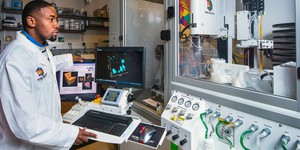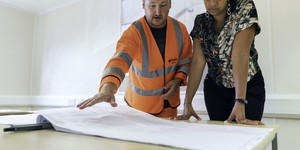Abstract
Have you ever broken a fishing rod? Or seen a treetop bend over and touch the ground (or even snap off) during an ice storm? These are examples of the effect of bending stresses on flexible rods. There are scientists who actually study this phenomenon and discover ways to prevent breakage, which leads to stronger fishing rods, building materials, car parts, and more. In this science project, you'll explore the bending stresses in flexible rods by testing asparagus stalks.Summary
Kristin Strong, Science Buddies
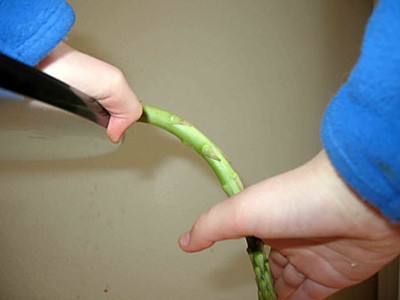
Objective
In this science project, you will modify the point of bending failure and the maximum bending stress in a model of a flexible rod.
Introduction
So what do dipsticks, bow and arrows, car antennas, fishing poles, pole vaults, kites, tents, dryer vent brushes, surgical probes, and fly swatters have in common? They're all so different, it's hard to imagine, right? Well, to work, they all use a flexible rod-a long, slender, bendable cylinder. Flexible rods are found throughout the automotive and construction industries. Some historians even think they were used to help build the Great Pyramids of Egypt. Flexible rods are also important in building instruments for medical testing and treatment, since the human body is made up of many curved vessels and tubes, and flexibility is essential to maneuver through those curves.
Whether it's hollow or solid, when a flexible rod is bent, almost all the stress occurs at the surface of the rod, as shown in Figure 1. In designing the rod, mechanical engineers and materials scientists think about how much bending the rod will undergo during normal use, and how many times it will be bent. They want to avoid structural failure of the rod, so they choose the right material, limit bending motion, and avoid designs that concentrate stress along the length of the rod as it bends.
 Image Credit: Kristin Strong, Science Buddies / Science Buddies
Image Credit: Kristin Strong, Science Buddies / Science Buddies
Have you ever tried to open a cellophane bag of chips or candy? It's usually very hard to rip open the bag unless you find the special notch in the packaging, or unless you make a notch yourself with your teeth or scissors. This notch is an example of a stress riser, a place where stress concentrates, and cracks can start and grow. A flexible rod can withstand greater bending forces if the stresses are evenly spread out along the length of the rod. However, if there is a concentration of stress along the rod-for example, at a joint, drill hole, or notch-as shown in Figure 2, then a crack may form and grow when the rod is bent, and the rod will break, even under normal bending forces.
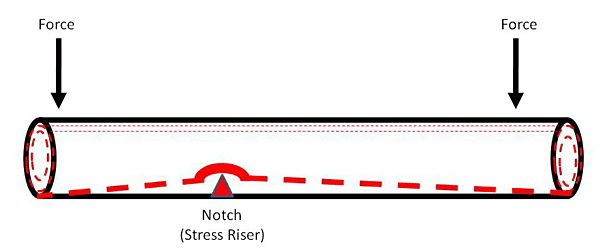 Image Credit: Kristin Strong, Science Buddies / Science Buddies
Image Credit: Kristin Strong, Science Buddies / Science Buddies
In this science project, you'll find the place where a flexible rod model tends to break naturally when it is tested in bending to the point of failure, meaning you'll identify the location of the maximum bending stress. Then you'll see if you can modify where the flexible rod model experiences bending failure by introducing stress risers, or points of stress concentration or stress accumulation.
For the experimental procedure, you'll be using asparagus stalks as models of a flexible rod. You'll bend the asparagus stalks until they break, both with and without bands. The bands are stress risers and introduce a point of stress concentration. Where do you think the asparagus stalks will break when they are not banded? How about when they are banded?
Terms and Concepts
To do this project, you should do research that enables you to understand the following terms and concepts:
- Stress
- Structural failure
- 2-point bending test
- Stress riser
- Force
- Maximum bending stress
- Bending failure
- Stress concentration
- Stress accumulation
Questions
- Where does maximum bending stress occur in a flexible rod?
- Can you modify the point of maximum bending stress? How?
Bibliography
- A good place to start is this Science Buddies resource written by Stanford Mechanical Engineering Professor Beth Pruitt and her students: Stress, Strain, & Strength.
- This source discusses the concepts of stress accumulation and stress concentration:
Wikipedia contributors. (2008). Stress Concentration. Wikipedia: The Free Encylopedia. Retrieved March 6, 2008.
Materials and Equipment
For this science project you will need the following materials and equipment:
- Fat, fresh asparagus stalks, approximately 9 inches long (15)
- Chicken leg bands (12), available at farm animal supply stores. An alternative is any thin, strong, metal or plastic adjustable banding material that can be snugly wrapped around an asparagus stalk at any point along its length, such as a cable tie.
- Measuring tape
- Lab notebook
- Digital camera (optional)
- Graph paper
Experimental Procedure
-
Divide the asparagus into five groups of three asparagus each.
Band each asparagus stalk as follows:
Group Banding, in Inches from the Cut End A (control) Unbanded B 2 C 4 D 5 E 6
-
Make five data tables (one for each group), as shown below, to record your measurements:
Group A (control) Asparagus 1 Asparagus 2 Asparagus 3 Total length Break length=length from cut end to break Break ratio=Break length/Total length
- Doing on group at a time, measure and record the total length of each asparagus stalk.
-
For each asparagus stalk, hold the very end of the cut end down against the edge of a tabletop with one hand. With the other hand, bend the asparagus tip down until the asparagus breaks (experiences structural bending failure).
 Figure 3. Asparagus stalk from Group A (control group) being tested until bending failure.
Figure 3. Asparagus stalk from Group A (control group) being tested until bending failure.
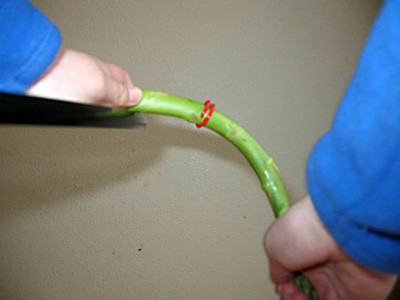 Image Credit: Kristin Strong, Science Buddies / Science Buddies
Figure 4. Asparagus stalk from Group B (banded 2 inches from cut end) being tested until bending failure.
Image Credit: Kristin Strong, Science Buddies / Science Buddies
Figure 4. Asparagus stalk from Group B (banded 2 inches from cut end) being tested until bending failure.
- Measure the length of the cut end to the break.
- As you continue breaking each stalk, try to hold each one in exactly the same way as the others. Repeat steps 3-5 for the other four groups.
-
For each group, calculate the average break ratio as follows: Sum the break ratios for asparagus 1, asparagus 2, and asparagus 3 in each group. Then divide by 3. Record your results in a data table like the one below:
Group Description Average Break Ratio Group A, control group (no bands) Group B (banded 2 inches up from cut end) Group C (banded 4 inches up from cut end) Group D (banded 5 inches up from cut end) Group E (banded 6 inches up from cut end)
- Take photographs of the broken asparagus stalks for your display board, if desired.
- Plot the average break ratio (y-axis) against the banding distance from the cut end (x-axis). What was the maximum bending stress point where the asparagus tended to break "naturally" (without banding)? Did banding affect the maximum bending stress break point? Could you bend the tip farther down with or without banding?
- Now wash, steam, and eat your asparagus tips!
Ask an Expert
Global Connections
The United Nations Sustainable Development Goals (UNSDGs) are a blueprint to achieve a better and more sustainable future for all.
Variations
- Repeat the experiment using multiple bands, first two and then three, simultaneously at different points along the length of the asparagus stalk. Does one of the bands seem to dominate or have a bigger impact on where the asparagus breaks?
- Devise a way to test the bending in stalks with weights so you can compare the forces required to induce failure for each of the different groups.
Careers
If you like this project, you might enjoy exploring these related careers:
Related Links
- Science Fair Project Guide
- Other Ideas Like This
- Mechanical Engineering Project Ideas
- My Favorites
- Stress, Strain, & Strength





